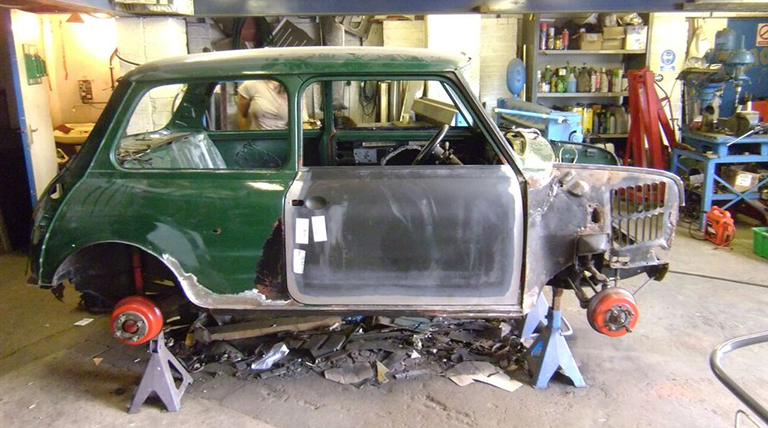Despite knowing it was coming for me, I decided to post one of my recent sketches to Instagram and Facebook … and I was murdered. For 95% of those folks doing the murdering, their intentions were honest and well intended. For the other 5%, … I won’t say what I want to say.
For those of you who don’t participate or follow me on Instagram or Facebook, I’ll give you a little taste of what I mean – but I’m going to use a slightly different example so that we can find some common ground in how we take things. Once you’ve had a chance to read through it, you can come to your own conclusions about that other 5%.
Make sure you don’t have any sharp instruments within reach or you might intentionally stab yourself in the face.
Pretend that this next picture was what I shared with everybody.

Bob: Check it out everybody, I am restoring this classic mini cooper!
#classiccar #gonnabeamazing #whatIdoinmysparetime
Internet Person: Hey Bro, you’re going to need wheels if you want that car to move.
Internet Person: I LOVE that green paint color but it looks like you missed the passenger door. It looks gray but I think it would be better if it matched the green part.
Internet Person: Where’s the engine?
Internet Person: I love the orange wheels – they’re so cute! But they should probably be bigger.
Internet Person: One thing that many people forget is the value of having a bumper. I’ve had cars my whole life and let me tell you, bumpers are important.
Internet Person: Why would you only use two doors? Four doors are a lot better.
Internet Person: That car isn’t very big, how will you be able to move a giant armoire?
Internet Person: You shouldn’t restore a mini cooper, Camaro’s are a lot better
and scene … even though the comments just continued down this sort of path for quite some time. While I don’t generally mind people chiming in to share a thought, what killed me was just how ignorant people think I am.
Here was the sketch that got me murdered. There’s a lot going on here but guess what? It isn’t architecture … are you shocked? Don’t lie, some of you were and you let me know it.

I wrote a post years ago titled “Schematic Design – This Isn’t Architecture” and while I think you should go read it (because it’s amazing) I will save some of you the time and summarize. The schematic design and programming phase is typically one of my favorites because there is such a social aspect to the collection of the material needed to do a proper job. It’s important that I have a real working understanding of how the house will ultimately be used so that we can create a finished product that supports this family’s lifestyle. Since I tend to sketch when I talk, drawings and diagrams are created in real-time, right in front of the client, that reflect our conversation.
I am going to include a quote from that post I wrote in 2014 to show that this is not a new process for me – this is simply how I work:
As we are talking, I would ask questions and draw diagrams right in front of the clients to make sure we were on the same page. What was pretty cool was that my pen started being passed around the table as everyone started to get in on the sketching action. As I was drawing, I kept saying “This isn’t architecture … this is a diagram. Your house will not look like this.”
For some people, when I posted the sketch above, I clearly made their head explode and people came out of the woodwork to save me from myself and the horrible job I was inflicting on my client. The foolishness that I love [sarcasm – I actually hate it] is that people will tell me all the things I am doing wrong despite the fact that they know nothing about the project. They don’t know the existing conditions, the priorities of the client’s, the lifestyle they want to reinforce, the budget, who is going to be living in the house … nothing, but they’ll have zero issues with telling me how wrong everything is.
My takeaway, at least for those folks in the 5%, is that they must have a programming process completely foreign to me and that the way we include the client during this stage is so different that we must be on completely different wavelengths. I can’t imagine the client not having a say in the end product – even if they want something that I don’t agree with, they still get their say in the matter. Several comments I received on the sketch above were that I should flip the vanities so that his sink would be close to his closet. Do you not think I asked that question? Do you not think I know that a car needs wheels and an engine if I want it to run?!?
The project associated with the sketch above is a small project for me – much smaller than I would normally take on but I really like these folks and I want to work with them. Part of what we are going through is aligning their budget with their goals – which means assigning priorities to everything they want so that we can barter and trade our way through the list to maximize value. This isn’t rocket science, but it does involve conversations that involve cause and effect – and it is frequently easier for me to simply sketch these things while we are talking during the programming phase to clarify a point.
In every residential project I have ever done, I have told the client that there will be a moment where I get to play the “trust me” card – that there will be a moment where they want something that I feel so strongly about that I get to slap this card down and I get an instant win. In exchange for granting me this one card, I will not fight them on anything else. If they want something that I don’t think is a good idea, I will try to educate them on their options so that they can make an informed decision. If I do that and they still don’t agree with me, that’s where ownership comes in and every client deserves to have it on their project.




